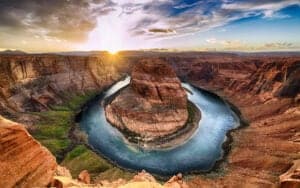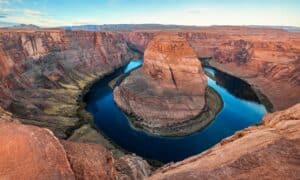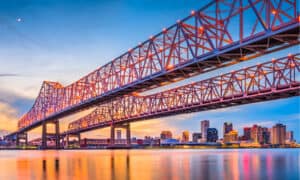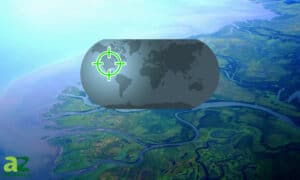What is the Widest Part on the Colorado River?
The Colorado River is famous for carving out one of the Seven Wonders of the Natural World, the Grand Canyon. The River starts as a small trout lake, La Poudre Pass Lake, in the Rocky Mountains and travels 1,450 miles down to Mexico to empty into the Gulf of California. Along the way it twists and turns sometimes forming crazy horseshoe-shaped curves making its way down to the Gulf.
We have harnessed the mighty power of the river along the way creating a system of dams and reservoirs to create power and supply fresh water to surrounding communities. As the River ebbs and flow it widens significantly at artificially made reservoirs along its path. These are some of the widest parts on the Colorado River!
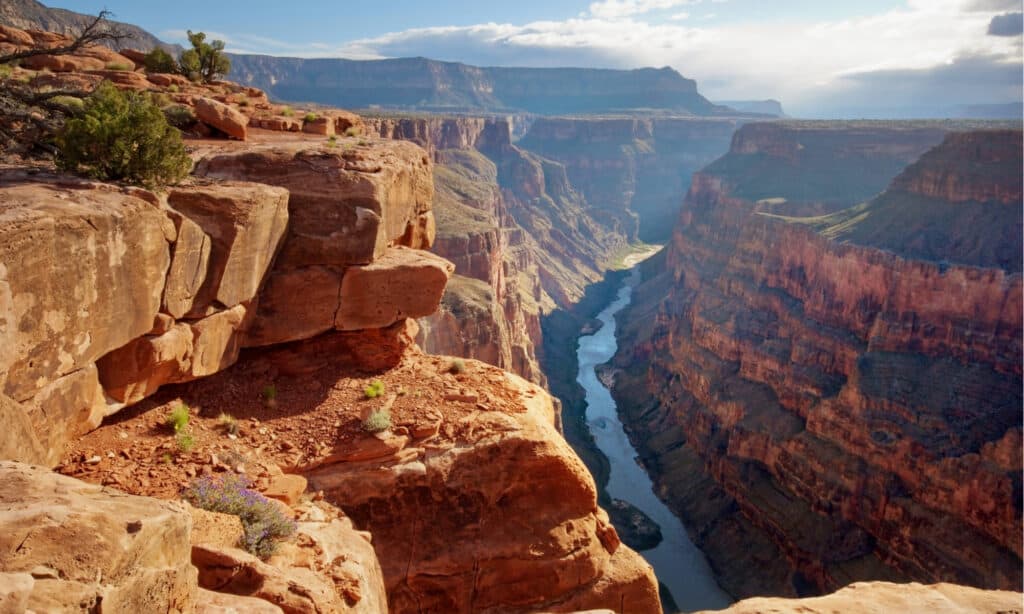
sumikophoto/Shutterstock.com
Shadow Mountain Reservoir
The Shadow Mountain Reservoir is about 55 miles NW of Denver. It is about 18 miles downstream from the headwaters of the Colorado River. Here the river passes through the 3-mile-long reservoir heading south towards Granby Lake. The Shadow Mountain Reservoir is connected to Grand Lake to the North. Grand Lake is actually the largest natural lake in Colorado. The widest part of the Shadow Mountain Reservoir is 3 miles from north to south.
| Closest City | Grand Lake, Colorado |
| Area | 1,346 surface acres |
| Wide | 4,960 feet |
| Long | 3 miles |
| Natural or Reservoir | Reservoirs |
| Dam | Shadow Mountain Dam, built 1944-1946 |
| Fun Fact | Connects to Grand Lake which is the largest natural lake in Colorado |
Lake Granby
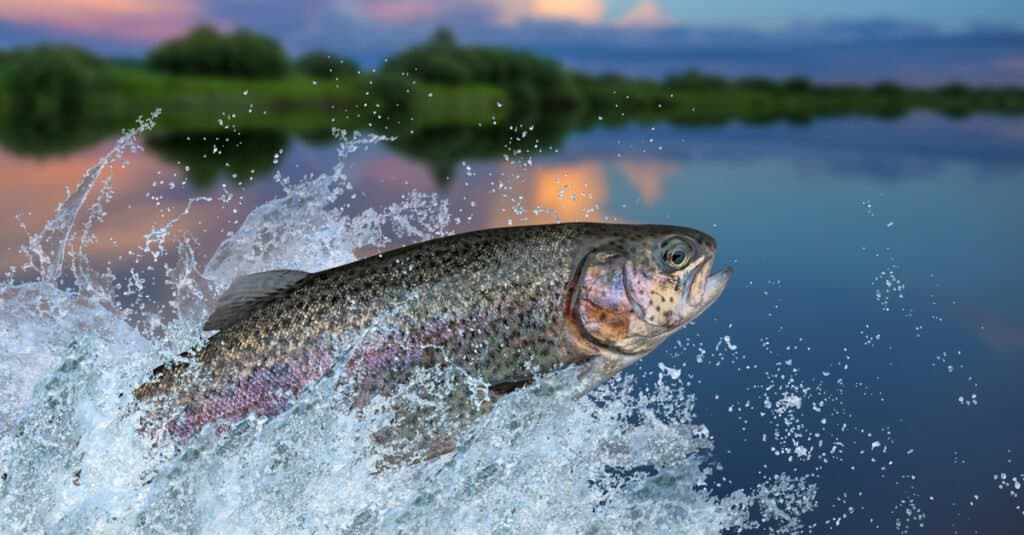
FedBul/Shutterstock.com
Lake Granby is about 7 miles downstream from the Shadow Mountain Reservoir. This large reservoir is about 8 miles long and 2 miles wide. The Colorado River passes through the middle of the lake from the north to the south cutting across around 1.8 miles of the lake to continue on the other side. It is the fourth-largest body of water in Colorado. With 40 miles of shoreline, it is a popular recreational lake for boating and fishing. It is stocked with trout and kokanee salmon. Maybe look up some Garlic Lemon Butter Herb Trout recipes!
| Closest City | Granby, Colorado |
| Area | 11.34 square miles |
| Wide | 2 miles |
| Long | 8.3 miles |
| Natural or Reservoir | Reservoir |
| Dam | Granby Dam, built 1950 |
| Fun Fact | Third largest body of water in Colorado |
Windy Gap Reservoir
The Windy Gap Reservoir is not far from Lake Granby. It actually works with the Lake Granby water system to provide extra water to the reservoir through the Windy Gap Pump Plant. In the 1960s when the cities around this area began to grow, the need for water increased and the Windy Gap Reservoir was completed in 1985 to meet the gap. One unique feature of the Windy Gap Reservoir is that it is almost completely square. A fun trivia question about “Can a River be Square?” technically it can for a short time before moving on downstream.
| Closest City | Granby, Colorado |
| Area | 445 acre feet |
| Wide | 2,050 feet |
| Long | 2,200 feet |
| Natural or Reservoir | Reservoir |
| Dam | Windy Gap Pump Plant, 1985 |
| Fun Fact | Delivers an average of 48,000 acre-feet of water per year to surrounding communities. |
Lake Powell
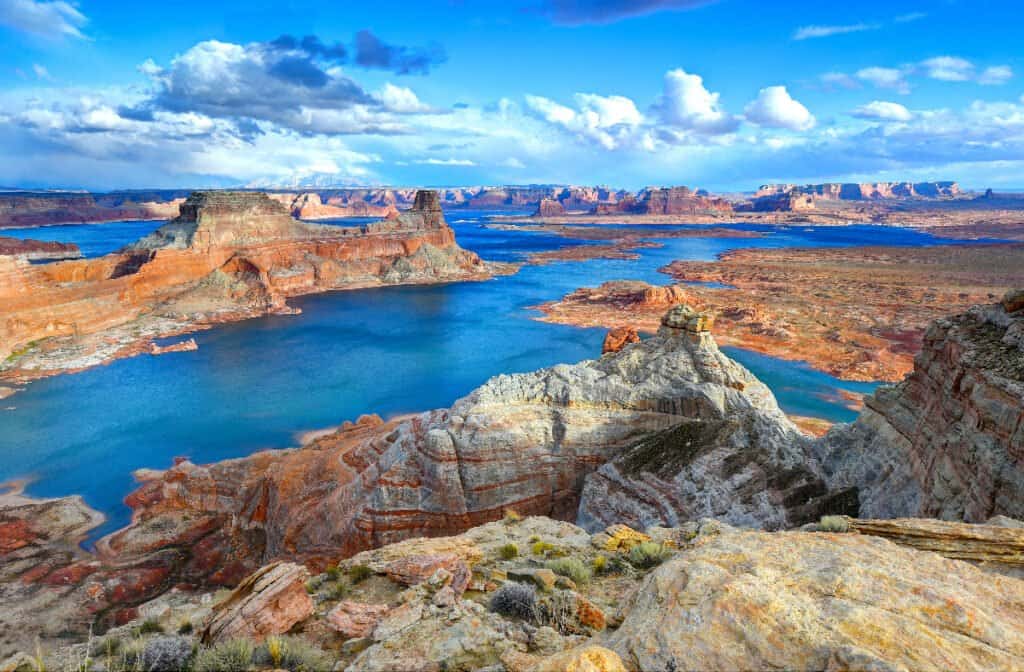
worldswildlifewonders/Shutterstock.com
Lake Powell is the second-largest reservoir in the United States. It is 185 miles long! The widest point is 25 miles wide, the widest part of the Colorado River.
| Closest City | Lake Powell, Arizona |
| Area | 254.1 square miles |
| Wide | 25 miles |
| Long | 185 miles |
| Natural or Reservoir | Reservoirs |
| Dam | Glen Canyon Dam, 1966 |
| Fun Fact | 2nd largest artificial reservoir in the US |
| Not so Fun Fact | Due to climate change and unprecedented drought, Lake Powell is at its lowest level in decades. |
Lake Mead

iStock.com/Sean Pavone
Lake Mead is the largest artificial reservoir in the US. It is situated just above the Hoover Dam. When you compare stats it may look like Lake Powell is actually bigger but when it comes down to the amount of water each one holds Lake Mead is a million-acre feet bigger. Lake Mead can hold 28 million acre-feet of water and Lake Powell can hold 27 million. Now, during this 20-year drought, it is a major concern that neither lake is anywhere near capacity and at the point of critically low levels. Authorities and researchers are working together to come up with a long-term plan to raise and maintain the water levels in both lakes.
| Closest City | 24 miles east of Las Vegas |
| Area | 247 square miles |
| Wide | 10 miles |
| Long | 115 miles |
| Natural or Reservoir | Reservoir |
| Dam | Hoover Dam, 1931 |
| Fun Fact | Largest artificial reservoir in the US |
| Not so Fun Fact | Due to climate change and unprecedented drought, Lake Powell is at its lowest level since 1937. |
Lake Mohave
Lake Mohave is not really near any cities but has several resorts along its beautiful shorelines. It is located on the Arizona/Nevada border and is contained by the Davis Dam. As part of the Mexican Treaty of 1944, the US and Mexico agreed to work together to allocate the water resources that flow from the Colorado River. The Davis Dam was created and monitors the flow from the Hoover Dam as well as the flow into Mexico.
| Closest City | Between Boulder City, NV and Laughlin, NV |
| Area | 41.41 square miles |
| Wide | 4 miles |
| Long | 67 miles |
| Natural or Reservoir | Reservoir |
| Dam | Davis Dam, 1944 |
| Fun Fact | A treaty was reached with Mexico to help regulate the flow of water into Mexico from the US, the Davis Dam was part of that solution of the Mexican Treaty of 1944. |
Lake Havasu

Pamela Au/Shutterstock.com
The last major swell of the Colorado River before it empties into the Gulf of Mexico is Lake Havasu. It is created by the Parker Dam that was built in the mid-1930s and created the beautiful Lake Havasu. The waters of the Lake are turquoise blue and attract many tourists, especially during spring break. Boating, fishing, kayaking and paddleboarding are very popular here. The widest part of the Colorado River is not in Lake Havasu although it does expand to almost 3 miles wide and 26 miles long.
| Closest City | Lake Havasu City, Arizona |
| Area | 30.16 square miles |
| Wide | 2.85 miles |
| Long | 26.3 miles |
| Natural or Reservoir | Reservoir |
| Dam | Parker Dam, 1934-1938 |
| Fun Fact | Also used as a recreational lake, has turquoise blue waters. |
So what is the widest point on the Colorado River?
The average width of the Colorado River is 300 feet across. Where the river swells into lakes and reservoirs it can expand to 25 miles across! The widest point of the Colorado River is in Lake Powell where it is 25 miles wide! The river’s deepest point is about 85 feet and corresponds to where it is very narrow while coursing through the Grand Canyon.
More from A-Z Animals
The Colorado River is famous for carving out one of the Seven Wonders of the Natural World, the Grand Canyon. The River starts as a small trout lake, La Poudre Pass Lake, in the Rocky Mountains and travels 1,450 miles down to Mexico to empty into the Gulf of California. Along the way it twists and turns sometimes forming crazy horseshoe-shaped curves making its way down to the Gulf.
We have harnessed the mighty power of the river along the way creating a system of dams and reservoirs to create power and supply fresh water to surrounding communities. As the River ebbs and flow it widens significantly at artificially made reservoirs along its path. These are some of the widest parts on the Colorado River!

sumikophoto/Shutterstock.com
Shadow Mountain Reservoir
The Shadow Mountain Reservoir is about 55 miles NW of Denver. It is about 18 miles downstream from the headwaters of the Colorado River. Here the river passes through the 3-mile-long reservoir heading south towards Granby Lake. The Shadow Mountain Reservoir is connected to Grand Lake to the North. Grand Lake is actually the largest natural lake in Colorado. The widest part of the Shadow Mountain Reservoir is 3 miles from north to south.
| Closest City | Grand Lake, Colorado |
| Area | 1,346 surface acres |
| Wide | 4,960 feet |
| Long | 3 miles |
| Natural or Reservoir | Reservoirs |
| Dam | Shadow Mountain Dam, built 1944-1946 |
| Fun Fact | Connects to Grand Lake which is the largest natural lake in Colorado |
Lake Granby

FedBul/Shutterstock.com
Lake Granby is about 7 miles downstream from the Shadow Mountain Reservoir. This large reservoir is about 8 miles long and 2 miles wide. The Colorado River passes through the middle of the lake from the north to the south cutting across around 1.8 miles of the lake to continue on the other side. It is the fourth-largest body of water in Colorado. With 40 miles of shoreline, it is a popular recreational lake for boating and fishing. It is stocked with trout and kokanee salmon. Maybe look up some Garlic Lemon Butter Herb Trout recipes!
| Closest City | Granby, Colorado |
| Area | 11.34 square miles |
| Wide | 2 miles |
| Long | 8.3 miles |
| Natural or Reservoir | Reservoir |
| Dam | Granby Dam, built 1950 |
| Fun Fact | Third largest body of water in Colorado |
Windy Gap Reservoir
The Windy Gap Reservoir is not far from Lake Granby. It actually works with the Lake Granby water system to provide extra water to the reservoir through the Windy Gap Pump Plant. In the 1960s when the cities around this area began to grow, the need for water increased and the Windy Gap Reservoir was completed in 1985 to meet the gap. One unique feature of the Windy Gap Reservoir is that it is almost completely square. A fun trivia question about “Can a River be Square?” technically it can for a short time before moving on downstream.
| Closest City | Granby, Colorado |
| Area | 445 acre feet |
| Wide | 2,050 feet |
| Long | 2,200 feet |
| Natural or Reservoir | Reservoir |
| Dam | Windy Gap Pump Plant, 1985 |
| Fun Fact | Delivers an average of 48,000 acre-feet of water per year to surrounding communities. |
Lake Powell

worldswildlifewonders/Shutterstock.com
Lake Powell is the second-largest reservoir in the United States. It is 185 miles long! The widest point is 25 miles wide, the widest part of the Colorado River.
| Closest City | Lake Powell, Arizona |
| Area | 254.1 square miles |
| Wide | 25 miles |
| Long | 185 miles |
| Natural or Reservoir | Reservoirs |
| Dam | Glen Canyon Dam, 1966 |
| Fun Fact | 2nd largest artificial reservoir in the US |
| Not so Fun Fact | Due to climate change and unprecedented drought, Lake Powell is at its lowest level in decades. |
Lake Mead

iStock.com/Sean Pavone
Lake Mead is the largest artificial reservoir in the US. It is situated just above the Hoover Dam. When you compare stats it may look like Lake Powell is actually bigger but when it comes down to the amount of water each one holds Lake Mead is a million-acre feet bigger. Lake Mead can hold 28 million acre-feet of water and Lake Powell can hold 27 million. Now, during this 20-year drought, it is a major concern that neither lake is anywhere near capacity and at the point of critically low levels. Authorities and researchers are working together to come up with a long-term plan to raise and maintain the water levels in both lakes.
| Closest City | 24 miles east of Las Vegas |
| Area | 247 square miles |
| Wide | 10 miles |
| Long | 115 miles |
| Natural or Reservoir | Reservoir |
| Dam | Hoover Dam, 1931 |
| Fun Fact | Largest artificial reservoir in the US |
| Not so Fun Fact | Due to climate change and unprecedented drought, Lake Powell is at its lowest level since 1937. |
Lake Mohave
Lake Mohave is not really near any cities but has several resorts along its beautiful shorelines. It is located on the Arizona/Nevada border and is contained by the Davis Dam. As part of the Mexican Treaty of 1944, the US and Mexico agreed to work together to allocate the water resources that flow from the Colorado River. The Davis Dam was created and monitors the flow from the Hoover Dam as well as the flow into Mexico.
| Closest City | Between Boulder City, NV and Laughlin, NV |
| Area | 41.41 square miles |
| Wide | 4 miles |
| Long | 67 miles |
| Natural or Reservoir | Reservoir |
| Dam | Davis Dam, 1944 |
| Fun Fact | A treaty was reached with Mexico to help regulate the flow of water into Mexico from the US, the Davis Dam was part of that solution of the Mexican Treaty of 1944. |
Lake Havasu

Pamela Au/Shutterstock.com
The last major swell of the Colorado River before it empties into the Gulf of Mexico is Lake Havasu. It is created by the Parker Dam that was built in the mid-1930s and created the beautiful Lake Havasu. The waters of the Lake are turquoise blue and attract many tourists, especially during spring break. Boating, fishing, kayaking and paddleboarding are very popular here. The widest part of the Colorado River is not in Lake Havasu although it does expand to almost 3 miles wide and 26 miles long.
| Closest City | Lake Havasu City, Arizona |
| Area | 30.16 square miles |
| Wide | 2.85 miles |
| Long | 26.3 miles |
| Natural or Reservoir | Reservoir |
| Dam | Parker Dam, 1934-1938 |
| Fun Fact | Also used as a recreational lake, has turquoise blue waters. |
So what is the widest point on the Colorado River?
The average width of the Colorado River is 300 feet across. Where the river swells into lakes and reservoirs it can expand to 25 miles across! The widest point of the Colorado River is in Lake Powell where it is 25 miles wide! The river’s deepest point is about 85 feet and corresponds to where it is very narrow while coursing through the Grand Canyon.

